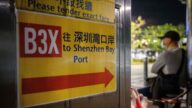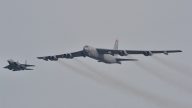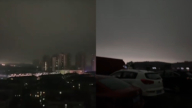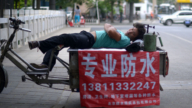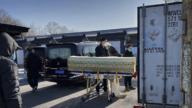【新唐人2013年11月26日訊】日前,中共當局高調宣佈設立「東海航空識別區」,要求飛入這一區域的航空器向中共政府通報飛行計劃,服從中共東海防空識別區管理機構的指令,對於拒不服從指令的航空器,將採取武力措施等。有評論認為,中共當局在國內矛盾不斷升級的情況下,拋出這一軍事行動,是為了挑起大陸民眾的所謂「愛國」情緒,轉移國內矛盾。請看以下報導。
23號,中共國防部宣佈設立「東海航空識別區」,這一公告在當天上午10點起生效。
中共設定的「東海航空識別區」範圍,是從北韓半島南側到台灣北側,包括了有爭議的釣魚島和東海油氣田。
旅美政論家、美國中文雜誌《中國事務》總編輯伍凡:「這個區包括釣魚島的上空,也包括日本勢力區的一部分,有重疊。這樣很可能就引起擦槍走火。這就引起東海上空緊張局勢就出來了,引起老百姓對中共抱有幻想。」
日本《NHK》電視臺11月25號報導,日本外相岸田文雄25號在國會參議院國家安全特別委員會上表示,「中方劃設的空域包含日本固有的領土釣魚島,這是可能在現場引發不測事態的單方面措施。」
香港城市大學政治學教授鄭宇碩﹕「它的舉動是提醒它的主權,從2010年開始,中國周邊的領海、領土糾紛,也同樣有所聞,中國(中共)目前的立場是採取種種措施來加強它的主權要求。 也是向日本施壓,也是回應國內民族主義的需求。」
伍凡:「中共面對黨內鬥爭、經濟下滑,老百姓反抗的聲音一直在往上升,它要把『愛國主義思想』提高起來,認為共產黨不是賣國的,把焦點移到這邊來,對降低社會壓力、黨內壓力是有好處的。所以它就設立這個區。」
釣魚島,全稱釣魚臺列島,簡稱釣魚島,在中國的明朝和清朝時期,一直是中國的領土,1895年,中、日「甲午戰爭」後,被日本佔領。
第二次世界大戰結束後,國、共兩黨爆發激烈的內戰,國民政府無暇顧及釣魚島。當時,美國以戰勝國名義對琉球群島實行託管統治,把釣魚島劃入託管的琉球群島範圍。
1949年,中共建政,到1971年,美國把琉球群島(包括釣魚島)轉交給日本。這二十多年中,中共不但沒有向美國交涉釣魚島的主權。而且,1953年1月和1958年3月,中共黨媒《人民日報》分別在兩篇文章裡表態「釣魚島屬於日本」。
但近年來,中共當局與日本在爭奪釣魚島主權上,表現強硬。「東海航空識別區」一經公布,兩架中共電子偵察機相繼進入識別區。但卻被日本戰機攔截。
岸田文雄強調,日本將同美國緊密合作,進行協商,並與有關國家一道要求中方保持克制。而美國白宮、國務院以及國防部都發表聲明,對中共進行警告。
旅美政論家、美國中文雜誌《中國事務》總編輯伍凡認為,中共設立「東海航空識別區」,也是在看美國和日本雙方的反應。
伍凡:「我認為中共設立這個區,是給美國和日本一個壓力,看看你們真的是聯手嗎?還是假的聯手。一旦這個地區發生衝突的時候,美國真的會介入嗎?下個月2號,美國副總統拜登要訪問北京,這個事情是一定要談的。美國的態度要告訴北京,是真的還是假的。」
伍凡認為,中共和日本的關係隨著設定航空識別區的建立,會越來越冷淡,包括政治冷淡、經濟冷淡,但,軍事關係會變的火熱。伍凡表示,中、日間可能產生小的摩擦,而小摩擦能夠轉移中國民眾的目標、轉移社會的視線,這也是中共的目地。
但是,香港城市大學政治學教授鄭宇碩表示,中、日發生戰爭的機會低。
鄭宇碩﹕「兩岸也好、中與日也好,都明白維持和平的重要性,絕對沒有意思要動武,所以,發生戰爭、衝突的危險是相當低的。」
同時,鄭宇碩表示,中、日領土之爭,短時間內很難解決。
採訪/易如 編輯/田淨 後製/孫寧
China Sets Air Defense Identification Zone to Divert Attention Away from Domestic Conflict
Recently, the Communist regime announced the Air Defense
Identification Zone (ADIZ) in which “China’s armed forces
will adopt defensive emergency measures to respond
to aircraft that do not co-operate in identification
or refuse to follow the instructions."
Commentators believe that this military decision is to divert
the ever-escalating domestic conflict with a patriotic sentiment.
On the 23rd, China’s defense ministry issued the Air Defense
Identification Zone (ADIZ), effective as of 10am that day.
The ADIZ imposes air-traffic restrictions from
the South Korean Peninsula to north of Taiwan,
including the skies over the disputed island group,
Diaoyu/Senkaku, and the East China Sea oil reserves.
Wu Fan, political commentator: “This area includes skies
over Diaoyu Islands and overlaps Japanese territories.
It is very easy to create accidents.
The rising tension over the east China Sea will cause
illusion for the Chinese people about the Communist regime."
According to an NHK World report, at a Nov. 25
Parliament session, Japan’s Prime Minister Shinzo Abe
criticized China for creating an ADIZ that includes airspace
above the Senkaku Islands.
He accused China’s unilateral action as being very dangerous,
as it escalates the situation and invites unexpected incident(s).
Joseph Yu-shek Cheng, political science professor,
City University of Hong Kong: “It is a move to remind people
of its sovereignty.
Since 2010, China has been involved in territorial disputes
involving water and land.
China (the communist regime) is taking all measures
to claim its sovereignty and put pressure on the Japanese
in responding to the needs of domestic nationalism."
Wu Fan: “Facing the party struggles, economic downturn
and rebellion from the people, the Chinese Communist Party
(CCP) is trying to bring up patriotism among the people
to reduce societal pressures on the party.
The ADIZ is set up to divert domestic focus."
Diaoyu Islands, also known as Senkaku Islands,
has been China’s territory since the Ming and Qing Dynasty.
After the 1895 Sino-Japanese War, it was occupied by Japan.
After World War II, a civil war broke out between
the Nationalist Kuomintang and the CCP.
The Nationalist government was not able to attend
to the islands.
The United States re-categorized them as part of the United
States Military Government of the Ryukyu Islands.
In 1949, the CCP took control of China.
In 1971, the islands reverted back to Japanese control under
the Okinawa Reversion Agreement between the US and Japan.
Since then, for over 20 years, the CCP has not only failed
to negotiate the sovereignty of the Diaoyu Islands with the US,
but it also claimed in two CCP-controlled People’s Daily
articles in January of 1953 and March of 1958 that,
“the Diaoyu Islands belong to Japan."
In recent years, the CCP has taken a stern attitude
in regards to the Diaoyu Islands.
Since the ADIZ came into force, two Chinese reconnaissance
planes flew over the East China Sea and met Japanese fighter
jets on Saturday afternoon.
Japan’s PM Shinzo Abe stressed that Japan will work closely
with the US and in consultation with relevant countries to ask
China to exercise restraint.
The White House, State Department and Defense Department
in the US issued warning statements to the Communist regime.
Political commentator Wu Fan believes that by issuing
an ADIZ the CCP is testing the reactions of Japan and the US.
Wu Fan: “I think the CCP’s ADIZ is meant to put pressure
on the US and Japan.
It』s a test to see if they can work together.
Should there be a conflict arising in the area,
will the US really intervene?
During US Vice President Joe Biden’s visit to Beijing
next month, this issue will certainly come up.
Beijing will know the stance the US is taking."
Wu Fan believes that political and economic relations between
China and Japan will turn cold because of the ADIZ.
However, military relations will become heated.
Wu Fan says that friction will occur
and divert domestic attention.
That is what the CCP is aiming for.
Joseph Yu-shek Cheng, political science professor,
City University of Hong Kong, indicates that the chance
of a war between China and Japan is very low.
Joseph Yu-shek Cheng: “Whether it’s between Taiwan
and China, or between China and Japan, everyone knows
the importance of peace.
Military actions will be unnecessary.
The risk of war is very low."
Meanwhile, Joseph Yu-shek Cheng says that the territory
dispute between China and Japan is unlikely to be resolved in the short term.
Interview/YiRu Edit/TianJing Post-Production/SunNing



